Fabrication of an All-Solid-State Carbonate Ion-Selective Electrode with Carbon Film as Transducer and Its Preliminary Application in Deep-Sea Hydrothermal Field Exploration
Abstract
:1. Introduction
2. Materials and Methods
2.1. Reagents and Apparatus
2.2. Preparation of the Electrode
2.2.1. Carbon Film Coating
2.2.2. Carbonate-Sensitive Film Coating
2.3. Evaluation of the Electrode
3. Results and Discussion
3.1. SEM Analyses
3.2. Potentiometric Performance of the Electrode
3.2.1. Linear Slope, Detection Limits and Calibration Curve
3.2.2. Repeatability, Stability, Lifespan and Response Time
3.2.3. Selectivity
3.3. Application at Southwest Indian Ocean Ridge
4. Conclusions
Author Contributions
Funding
Institutional Review Board Statement
Informed Consent Statement
Data Availability Statement
Conflicts of Interest
References
- Doney, S.C.; Ruckelshaus, M.; Duffy, J.E.; Barry, J.P.; Chan, F.; English, C.A.; Galindo, H.M.; Grebmeier, J.M.; Hollowed, A.B.; Knowlton, N.; et al. Climate Change Impacts on Marine Ecosystems. In Annual Review of Marine Science; Carlson, C.A., Giovannoni, S.J., Eds.; Annual Review of Marine Science; Annual Reviews: Palo Alto, CA, USA, 2012; Volume 4, pp. 11–37. [Google Scholar]
- Zickfeld, K.; Azevedo, D.; Mathesius, S.; Matthews, H.D. Asymmetry in the climate-carbon cycle response to positive and negative CO2 emissions. Nat. Clim. Chang. 2021, 11, 613–617 . [Google Scholar] [CrossRef]
- Dai, A.G.; Luo, D.H.; Song, M.R.; Liu, J.P. Arctic amplification is caused by sea-ice loss under increasing CO2. Nat. Commun. 2019, 10, 13. [Google Scholar] [CrossRef] [PubMed] [Green Version]
- Doney, S.C.; Fabry, V.J.; Feely, R.A.; Kleypas, J.A. Ocean Acidification: The Other CO2 Problem. Annu. Rev. Mar. Sci. 2009, 1, 169–192. [Google Scholar] [CrossRef] [Green Version]
- Chen, S.; Tao, C.; Zhou, J.; Zhang, G.; Qin, H.; Wang, Y.; Chen, D. The distribution characteristics of hydrothermal plume in mid-ocean ridge and its indicative role in polymetallic sulfide prospecting. Acta Oceanol. Sin. 2019, 41, 1–12. [Google Scholar] [CrossRef]
- Santana-Casiano, J.M.; Fraile-Nuez, E.; Gonzalez-Davila, M.; Baker, E.T.; Resing, J.A.; Walker, S.L. Significant discharge of CO2 from hydrothermalism associated with the submarine volcano of El Hierro Island. Sci. Rep. 2016, 6, 25686. [Google Scholar] [CrossRef] [PubMed]
- Beaulieu, S.E.; Baker, E.T.; German, C.R.; Maffei, A. An authoritative global database for active submarine hydrothermal vent fields. Geochem. Geophys. Geosyst. 2013, 14, 4892–4905. [Google Scholar] [CrossRef] [Green Version]
- Blackford, J.; Bull, J.M.; Cevatoglu, M.; Connelly, D.; Hauton, C.; James, R.H.; Lichtschlag, A.; Stahl, H.; Widdicombe, S.; Wright, I.C. Marine baseline and monitoring strategies for carbon dioxide capture and storage (CCS). Int. J. Greenh. Gas Control 2015, 38, 221–229. [Google Scholar] [CrossRef] [Green Version]
- Rubin, K.H.; Soule, S.A.; Chadwick, W.W.; Fornari, D.J.; Clague, D.A.; Embley, R.W.; Baker, E.T.; Perfit, M.R.; Caress, D.W.; Dziak, R.P. Volcanic Eruptions in the Deep Sea. Oceanography 2012, 25, 142–157. [Google Scholar] [CrossRef] [Green Version]
- Baker, E.T.; Chadwick, W.W.; Cowen, J.P.; Dziak, R.P.; Rubin, K.H.; Fornari, D.J. Hydrothermal discharge during submarine eruptions the importance of detection, response, and new technology. Oceanography 2012, 25, 128–141. [Google Scholar] [CrossRef]
- Ma, J.; Shu, H.L.; Yang, B.; Byrne, R.H.; Yuan, D.X. Spectrophotometric determination of pH and carbonate ion concentrations in seawater: Choices, constraints and consequences. Anal. Chim. Acta 2019, 1081, 18–31. [Google Scholar] [CrossRef]
- Sharp, J.D.; Byrne, R.H.; Liu, X.W.; Feely, R.A.; Cuyler, E.E.; Wanninkhof, R.; Alin, S.R. Spectrophotometric Determination of Carbonate Ion Concentrations: Elimination of Instrument-Dependent Offsets and Calculation of In Situ Saturation States. Environ. Sci. Technol. 2017, 51, 9127–9136. [Google Scholar] [CrossRef]
- Byrne, R.H.; Yao, W. Procedures for measurement of carbonate ion concentrations in seawater by direct spectrophotometric observations of Pb(II) complexation. Mar. Chem. 2008, 112, 128–135. [Google Scholar] [CrossRef]
- Engleman, E.E.; Jackson, L.L.; Norton, D.R. Determination of carbonate carbon in geological-materials by coulometric titration. Chem. Geol. 1985, 53, 125–128. [Google Scholar] [CrossRef]
- Weiss, R.F.; Craig, H. Precise shipboard determination of dissolved nitrogen, oxygen, argon, and total inorganic carbon by gas-chromatography. Deep Sea Res. 1973, 20, 291–303. [Google Scholar] [CrossRef]
- Broecker, W.; Gerard, R.; Ewing, M.; Heezen, B.C. Natural radiocarbon in the atlantic ocean. J. Geophys. Res. 1960, 65, 2903–2931. [Google Scholar] [CrossRef]
- Goyet, C.; Snover, A.K. High-accuracy measurements of total dissolved inorganic carbon in the ocean—Comparison of alternate detection methods. Mar. Chem. 1993, 44, 235–242. [Google Scholar] [CrossRef]
- An, Q.; Jia, F.; Xu, J.; Li, F.; Niu, L. Recent progress of all solid state ion selective electrode. Sci. Sin. Chim. 2017, 47, 524–531. [Google Scholar]
- Zhao, Y.; Han, C.; Huang, Y.; Qin, W.; Zhang, X.; Kan, Y.; Ye, Y. New All-solid-state Carbonate Ion-selective Electrode with Ag2CO3-BaCO3 as Sensitive Films. Chem. Res. Chin. Univ. 2016, 32, 655–660. [Google Scholar] [CrossRef]
- Mendecki, L.; Fayose, T.; Stockmal, K.A.; Wei, J.; Granados-Focil, S.; McGraw, C.M.; Radu, A. Robust and Ultrasensitive Polymer Membrane-Based Carbonate-Selective Electrodes. Anal. Chem. 2015, 87, 7515–7518. [Google Scholar] [CrossRef] [PubMed]
- Mei, B.; Liang, R.; Qin, W. Solid-contact polymeric membrane potentiometric sensors for determination of carbonate in seawater samples. Chin. J. Anal. Lab. 2017, 36, 1255–1258. [Google Scholar]
- Li, G.; Lyu, X.; Wang, Z.; Rong, Y.; Hu, R.; Luo, Z.; Wang, Y. All-solid-state carbonate-selective electrode based on screen-printed carbon paste electrode. Meas. Sci. Technol. 2017, 28, 025104. [Google Scholar] [CrossRef]
- Yu, S.Y.; Li, F.H.; Yin, T.J.; Liu, Y.M.; Pan, D.W.; Qin, W. A solid-contact Pb2+-selective electrode using poly(2-methoxy-5-(2′-ethylhexyloxy)-p-phenylene vinylene) as ion-to-electron transducer. Anal. Chim. Acta 2011, 702, 195–198. [Google Scholar] [CrossRef] [Green Version]
- Boubiche, N.; El Hamouchi, J.; Hulik, J.; Abdesslam, M.; Speisser, C.; Djeffal, F.; Le Normand, F. Kinetics of graphitization of thin diamond-like carbon (DLC) films catalyzed by transition metal. Diam. Relat. Mat. 2019, 91, 190–198. [Google Scholar] [CrossRef] [Green Version]
- Li, L.; Liu, A.; Xie, K.; Shi, Z. Preparation of Graphite Coating on Nickel Substrate by Molten Salt Electrolysis. J. Northeast. Univ. Nat. Sci. 2015, 36, 675–679. [Google Scholar]
- Yudasaka, M.; Kikuchi, R.; Matsui, T.; Ohki, Y.; Ota, E.; Yoshimura, S. Graphite film formation by chemical vapor deposition on Ni coated sapphire. Carbon 1996, 34, 763–767. [Google Scholar] [CrossRef]
- Wang, Z.; Wang, A.; Li, H.; Li, X.; Ke, P. Preparing Graphene Film Comprises Providing Substrate, Using Physical Vapor Deposition Method to Deposit Amorphous Carbon Film on Substrate and Depositing Nickel Film on Amorphous Carbon Film, and Annealing Amorphous Carbon and Nickel Film. Patent No CN109136842-A, 4 January 2019. [Google Scholar]
- Cui, Y.; Li, G.; Jiang, L.; Wang, S. Drawing a Diamond Coating on a Drawing Die Comprises e.g. Using DC Arc Plasma Jet Method to Depositing Diamond Coating on the Inner Hole of the Drawing Die, Placing Drawing Die to Be Processed into a Mold Bushing Assembly. Patent No CN110042361-A, 23 July 2019. [Google Scholar]
- Song, Q.S.; Xu, Q.; Xing, C.Y. Preparation of a gradient Ti-TiOC-carbon film by electro-deposition. Electrochem. Commun. 2012, 17, 6–9. [Google Scholar] [CrossRef]
- Prasai, D.; Tuberquia, J.C.; Harl, R.R.; Jennings, G.K.; Bolotin, K.I. Graphene: Corrosion-Inhibiting Coating. ACS Nano 2012, 6, 1102–1108. [Google Scholar] [CrossRef] [PubMed]
- Hameed, R.M.A.; Mohamed, I.M.A.; Al-Enizi, A.M.; Abutaleb, A.; Shaikh, S.F.; Yousef, A. Fabrication of electrospun nickel sulphide nanoparticles onto carbon nanofibers for efficient urea electro-oxidation in alkaline medium. Int. J. Hydrogen Energy 2021, 46, 12944–12960. [Google Scholar] [CrossRef]
- Filipe, O.M.S.; Brett, C.M.A. Characterization of carbon film electrodes for electroanalysis by electrochemical impedance. Electroanalysis 2004, 16, 994–1001. [Google Scholar] [CrossRef] [Green Version]
- Massot, L.; Chamelot, P.; Bouyer, F.; Taxil, P. Electrodeposition of carbon films from molten alkaline fluoride media. Electrochim. Acta 2002, 47, 1949–1957. [Google Scholar] [CrossRef]
- Hwang, S.H.; Iwamoto, R.; Okumura, T.; Kamataki, K.; Itagaki, N.; Koga, K.; Nakatani, T.; Shiratani, M. Comparison between Ar+CH4 cathode and anode coupling chemical vapor depositions of hydrogenated amorphous carbon films. Thin Solid Film. 2021, 729, 7. [Google Scholar] [CrossRef]
- Cai, B.; Tan, Y.F.; Tu, Y.Q.; Wang, X.L.; Xu, T. Effects of graphite content on microstructure and tribological properties of graphite/TiC/Ni-base alloy composite coatings. Trans. Nonferrous Met. Soc. China 2011, 21, 1741–1749. [Google Scholar] [CrossRef]
- Chen, X.H.; Chen, C.S.; Xiao, H.N.; Cheng, F.Q.; Zhan, G.; Yi, G.J. Corrosion behavior of carbon nanotubes—Ni composite coating. Surf. Coat. Technol. 2005, 191, 351–356. [Google Scholar] [CrossRef]
- Choi, Y.S.; Lvova, L.; Shin, J.H.; Oh, S.H.; Lee, C.S.; Kim, B.H.; Cha, G.S.; Nam, H. Determination of oceanic carbon dioxide using a carbonate-selective electrode. Anal. Chem. 2002, 74, 2435–2440. [Google Scholar] [CrossRef] [PubMed]
- Brumleve, T.R.; Buck, R.P. Numerical-solution of nernst-planck and poisson equation system with applications to membrane electrochemistry and solid-state physics. J. Electroanal. Chem. 1978, 90, 1–31. [Google Scholar] [CrossRef]
- Wu, J.B.; Zhou, Y.F.; Zhang, P.P.; Zhang, C.Q.; Ye, Y. An All-Solid-State Phosphate Ion-Selective Electrode Using BiPO4 as a Sensitive Membrane. Int. J. Electrochem. Sci. 2021, 16, 12. [Google Scholar] [CrossRef]
- Eren, H.; Uzun, H.; Andac, M.; Bilir, S. Potentiometric monitoring of cobalt in beer sample by solid contact ion selective electrode. J. Food Drug Anal. 2014, 22, 413–417. [Google Scholar] [CrossRef] [Green Version]
- Wu, R.R.; Chen, X.G.; Tao, C.H.; Huang, Y.F.; Ye, Y.; Wang, Q.J.; Zhou, Y.F.; Jin, Q.; Cai, W. An All-Solid-State Silicate Ion-Selective Electrode Using PbSiO3 as a Sensitive Membrane. Sensors 2019, 19, 525. [Google Scholar] [CrossRef] [Green Version]
- Tao, C.H.; Li, H.M.; Huang, W.; Han, X.Q.; Wu, G.H.; Su, X.; Zhou, N.; Lin, J.; He, Y.H.; Zhou, J.P. Mineralogical and geochemical features of sulfide chimneys from the 49A degrees 39′ E hydrothermal field on the Southwest Indian Ridge and their geological inferences. Chin. Sci. Bull. 2011, 56, 2828–2838. [Google Scholar] [CrossRef] [Green Version]
- Tao, C.H.; Lin, J.; Guo, S.Q.; Chen, Y.J.; Wu, G.H.; Han, X.Q.; German, C.R.; Yoerger, D.R.; Zhou, N.; Li, H.M.; et al. First active hydrothermal vents on an ultraslow-spreading center: Southwest Indian Ridge. Geology 2012, 40, 47–50. [Google Scholar] [CrossRef]
- Zhang, Y.X.; Liao, S.L.; Tao, C.H.; Wen, H.J.; Fan, H.F.; Wen, J.; Yang, W.F.; Li, W. Ga isotopic fractionation in sulfides from the Yuhuang and Duanqiao hydrothermal fields on the Southwest Indian Ridge. Geosci. Front. 2021, 12, 9. [Google Scholar] [CrossRef]
- Liao, S.L.; Zhu, C.W.; Zhou, J.P.; Liu, W.Y.; Yu, J.Y.; Liang, J.; Yang, W.F.; Li, W.; Liu, J.; Tao, C.H. Distal axis sulfide mineralization on the ultraslow-spreading Southwest Indian Ridge: An LA-ICP-MS study of pyrite from the East Longjing-2 hydrothermal field. Acta Oceanol. Sin. 2021, 40, 105–113. [Google Scholar] [CrossRef]
- Zhou, Y.D.; Zhang, D.S.; Zhang, R.Y.; Liu, Z.S.; Tao, C.H.; Lu, B.; Sun, D.; Xu, P.; Liu, R.C.; Wang, J.J.; et al. Characterization of vent fauna at three hydrothermal vent fields on the Southwest Indian Ridge: Implications for biogeography and interannual dynamics on ultraslow-spreading ridges. Deep Sea Res. Part I Oceanogr. Res. Pap. 2018, 137, 1–12. [Google Scholar] [CrossRef]
- Liao, S.L.; Tao, C.H.; Li, H.M.; Barriga, F.; Liang, J.; Yang, W.F.; Yu, J.Y.; Zhu, C.W. Bulk geochemistry, sulfur isotope characteristics of the Yuhuang-1 hydrothermal field on the ultraslow-spreading Southwest Indian Ridge. Ore Geol. Rev. 2018, 96, 13–27. [Google Scholar] [CrossRef]
- Tao, C.H.; Li, H.M.; Jin, X.B.; Zhou, J.P.; Wu, T.; He, Y.H.; Deng, X.M.; Gu, C.H.; Zhang, G.Y.; Liu, W.Y. Seafloor hydrothermal activity and polymetallic sulfide exploration on the southwest Indian ridge. Chin. Sci. Bull. 2014, 59, 2266–2276. [Google Scholar] [CrossRef]
- Wu, R.R.; Tao, C.H.; Chen, X.G.; Ye, Y.; Yue, X.H.; Huang, Y.Q.; Zhou, Y.F.; Wang, Q.Q. Fabrication of Multi-parameter Chemical Sensor and its Application in the Longqi Hydrothermal Field, Southwest Indian Ocean. Int. J. Electrochem. Sci. 2019, 14, 3871–3884. [Google Scholar] [CrossRef]
- Ding, Q.; Pan, Y.W.; Huang, Y.F.; Chen, C.T.A.; Ye, Y. The optimization of Ag/Ag2S electrode using carrier electroplating of nano silver particles and its preliminary application to offshore Kueishan Tao, Taiwan. Cont. Shelf Res. 2015, 111, 262–267. [Google Scholar] [CrossRef]
- Baumberger, T.; Lilley, M.D.; Lupton, J.E.; Baker, E.T.; Resing, J.A.; Buck, N.J.; Walker, S.L.; Fruh-Green, G.L. Dissolved Gas and Metal Composition of Hydrothermal Plumes From a 2008 Submarine Eruption on the Northeast Lau Spreading Center. Front. Mar. Sci. 2020, 7, 15. [Google Scholar] [CrossRef]
- German, C.R.; Baker, E.T.; Mevel, C.; Tamaki, K.; Team, F.S. Hydrothermal activity along the southwest Indian ridge. Nature 1998, 395, 490–493. [Google Scholar] [CrossRef]
- Baker, E.T.; Massoth, G.J. Characteristics of hydrothermal plumes from 2 vent fields on the juan-de-fuca ridge, northeast pacific-ocean. Earth Planet. Sci. Lett. 1987, 85, 59–73. [Google Scholar] [CrossRef]
- Shitashima, K. CO2 supply from deep-sea hydrothermal systems. Waste Manage. 1997, 17, 385–390. [Google Scholar] [CrossRef]
- Sakai, H.; Gamo, T.; Kim, E.S.; Tsutsumi, M.; Tanaka, T.; Ishibashi, J.; Wakita, H.; Yamano, M.; Oomori, T. Venting of carbon-dioxide rich fluid and hydrate formation in mid-okinawa trough backarc basin. Science 1990, 248, 1093–1096. [Google Scholar] [CrossRef] [PubMed]
- Yan, W.; Qu, Y.P.; Das Gupta, T.; Darga, A.; Nguyen, D.T.; Page, A.G.; Rossi, M.; Ceriotti, M.; Sorin, F. Semiconducting Nanowire-Based Optoelectronic Fibers. Adv. Mater. 2017, 29, 1700681. [Google Scholar] [CrossRef] [PubMed] [Green Version]
- Abouraddy, A.F.; Bayindir, M.; Benoit, G.; Hart, S.D.; Kuriki, K.; Orf, N.; Shapira, O.; Sorin, F.; Temelkuran, B.; Fink, Y. Towards multimaterial multifunctional fibres that see, hear, sense and communicate. Nat. Mater. 2007, 6, 336–347. [Google Scholar] [CrossRef] [PubMed]
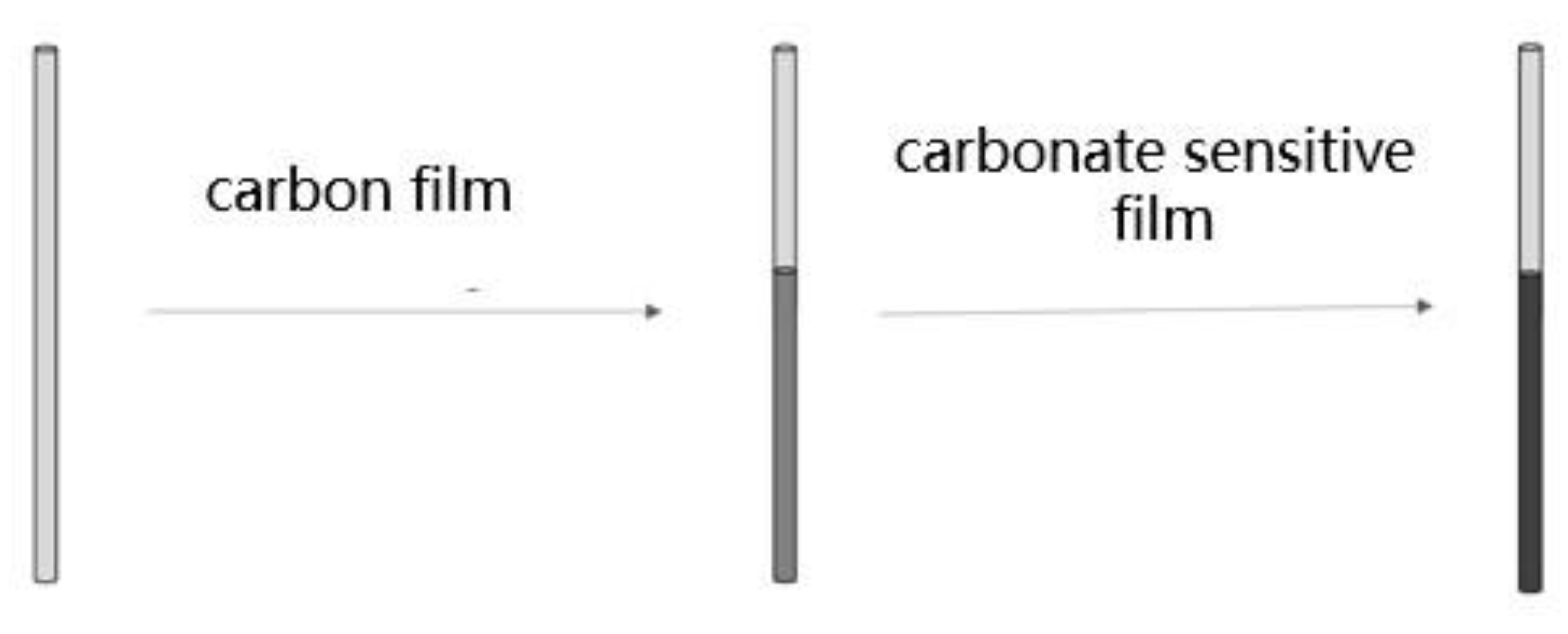
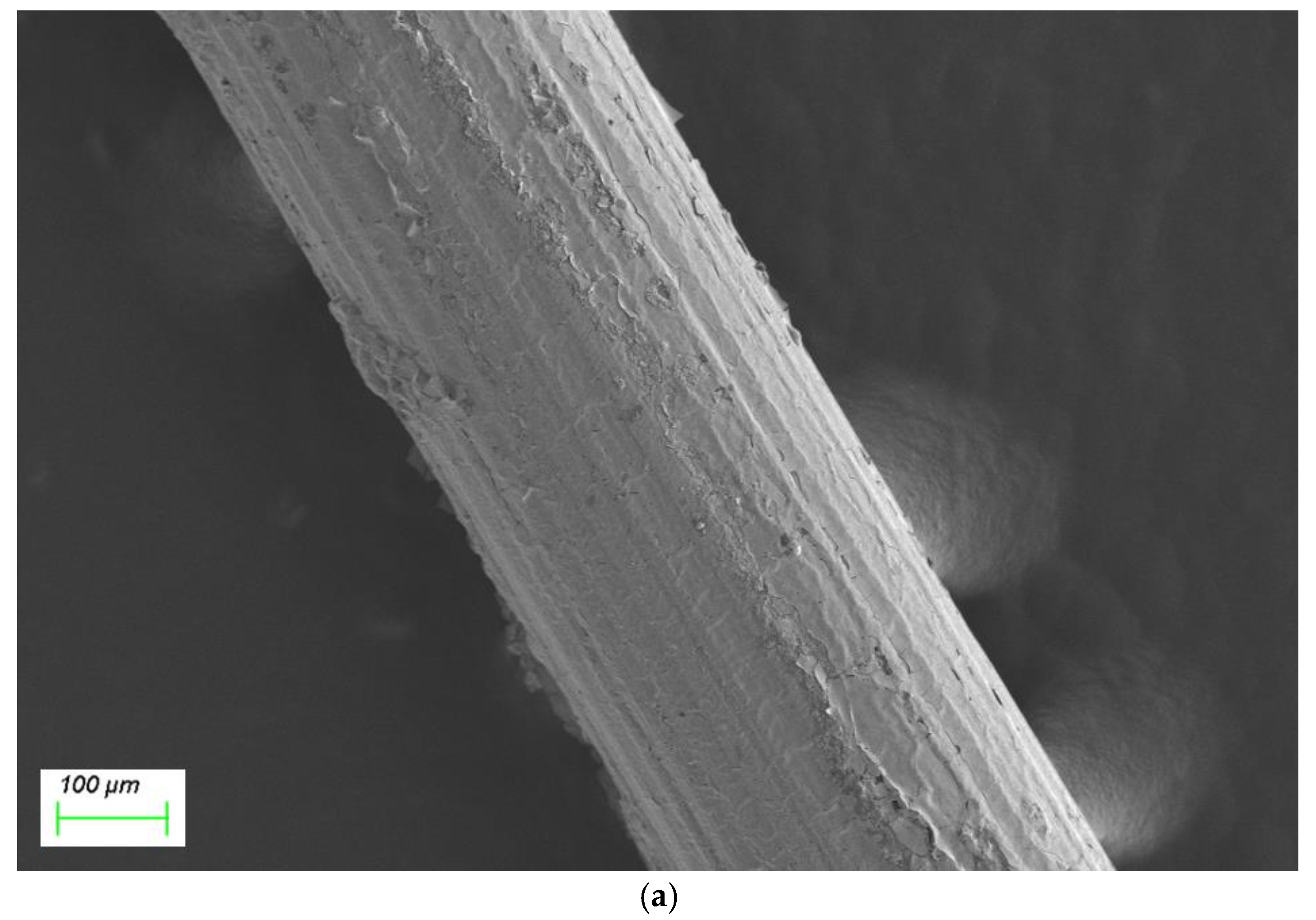
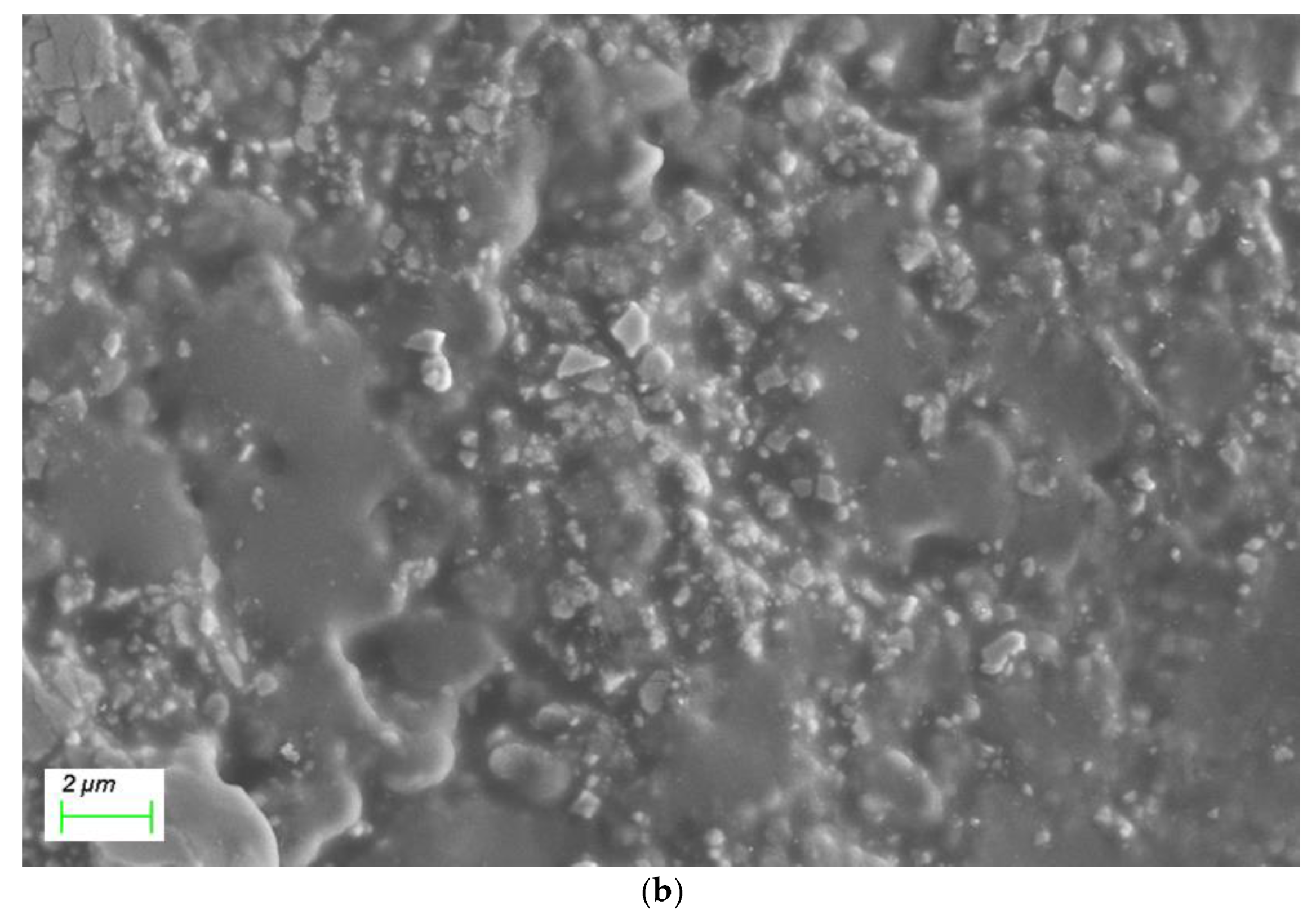
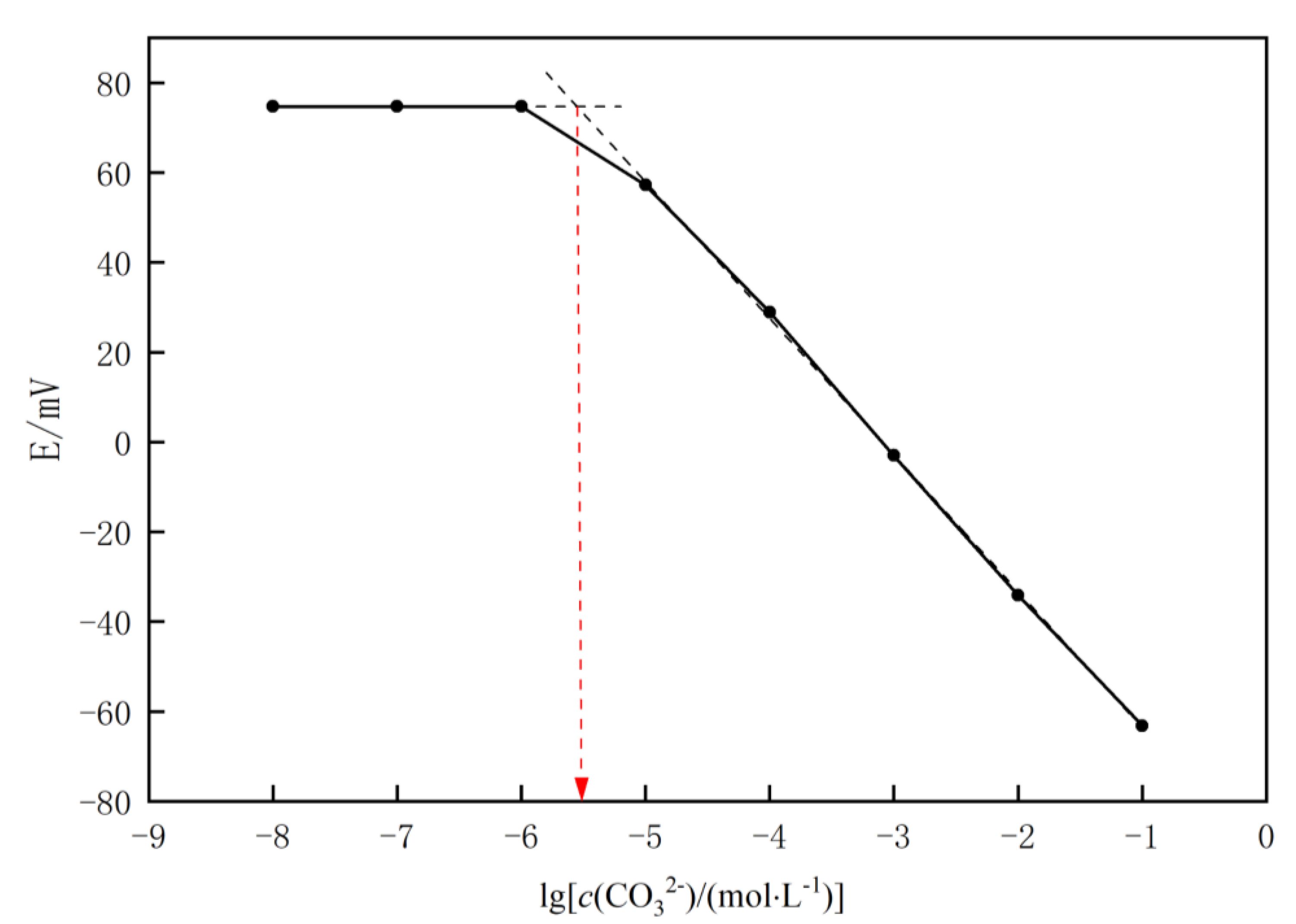
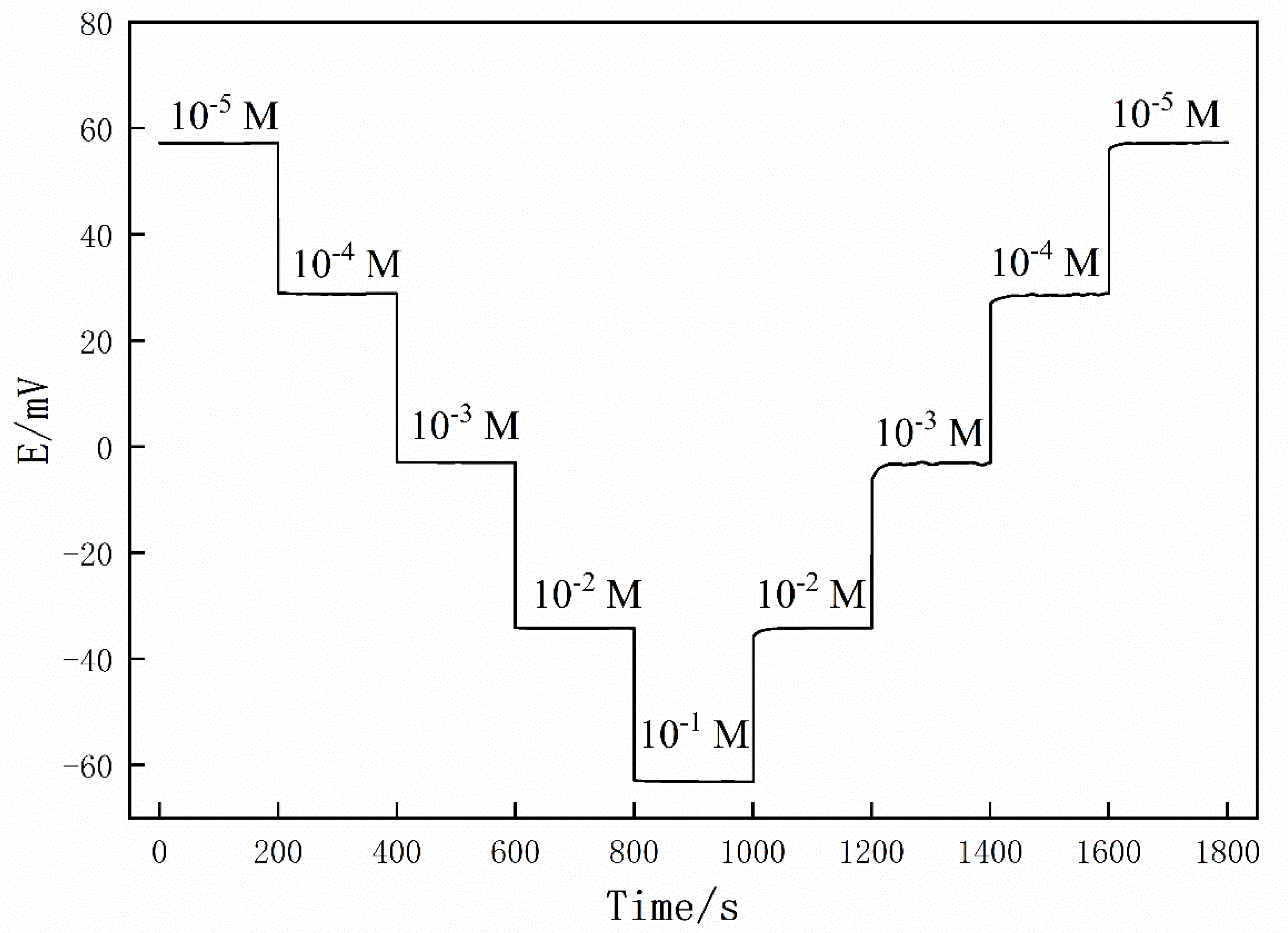
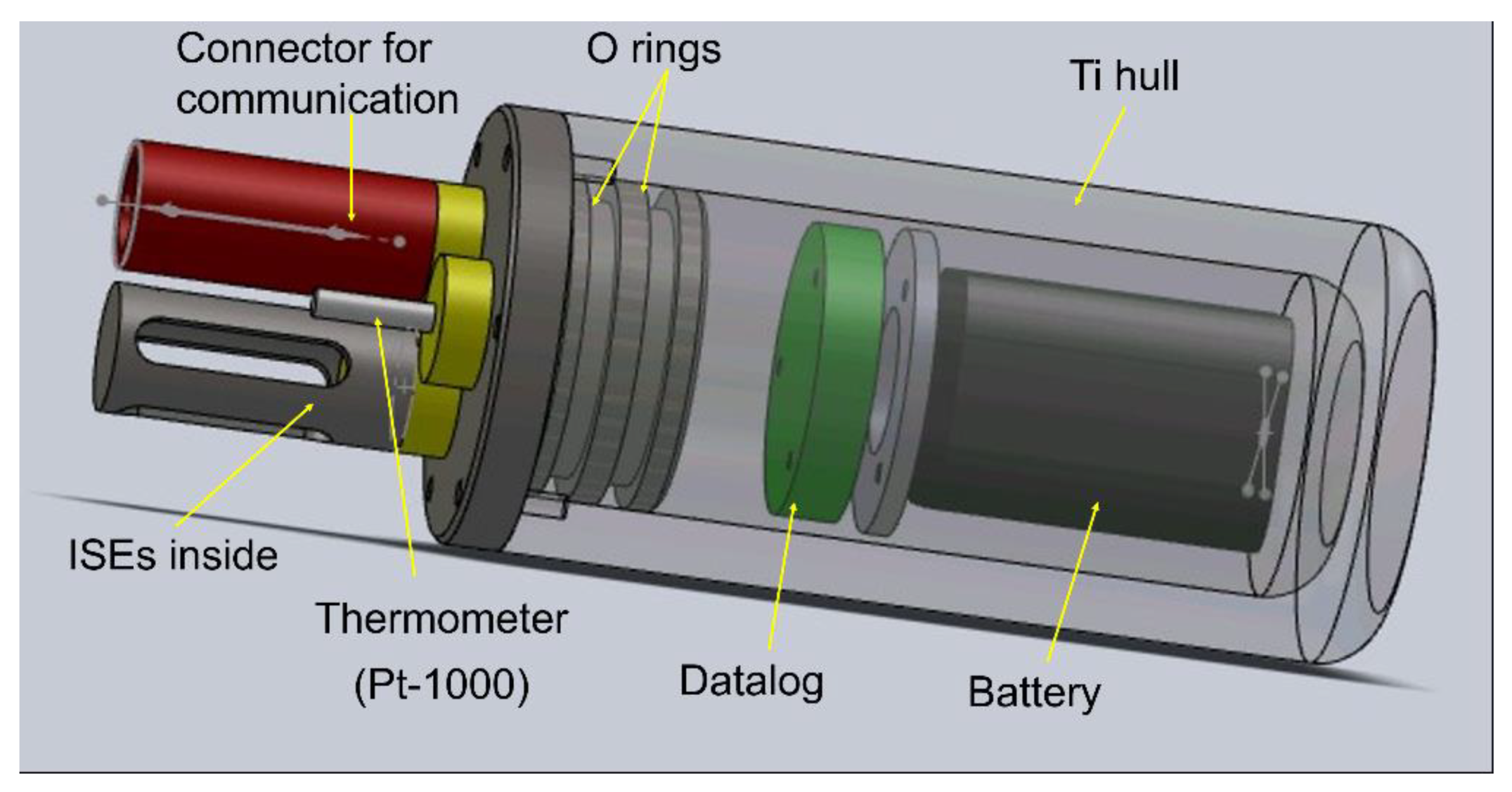
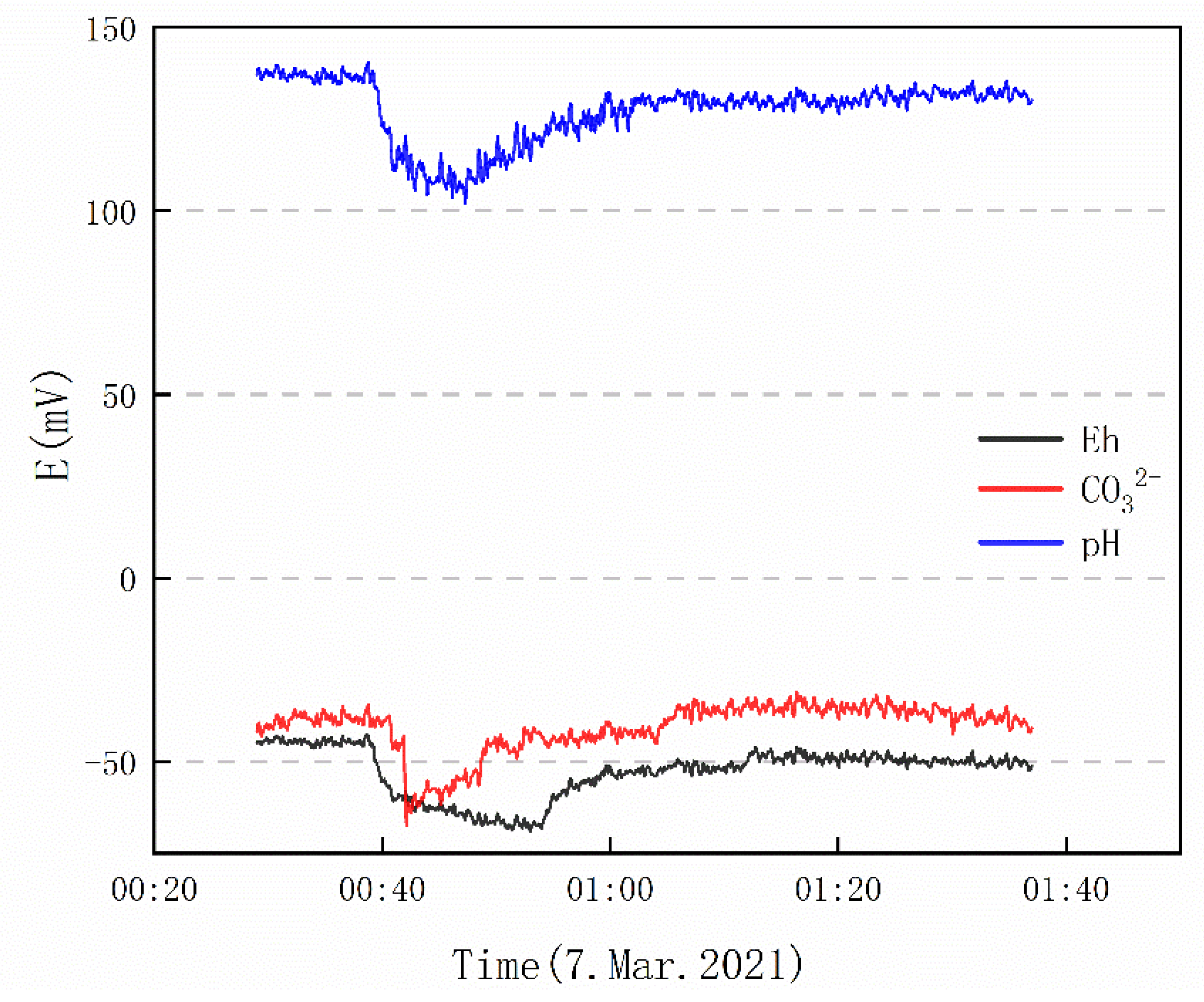
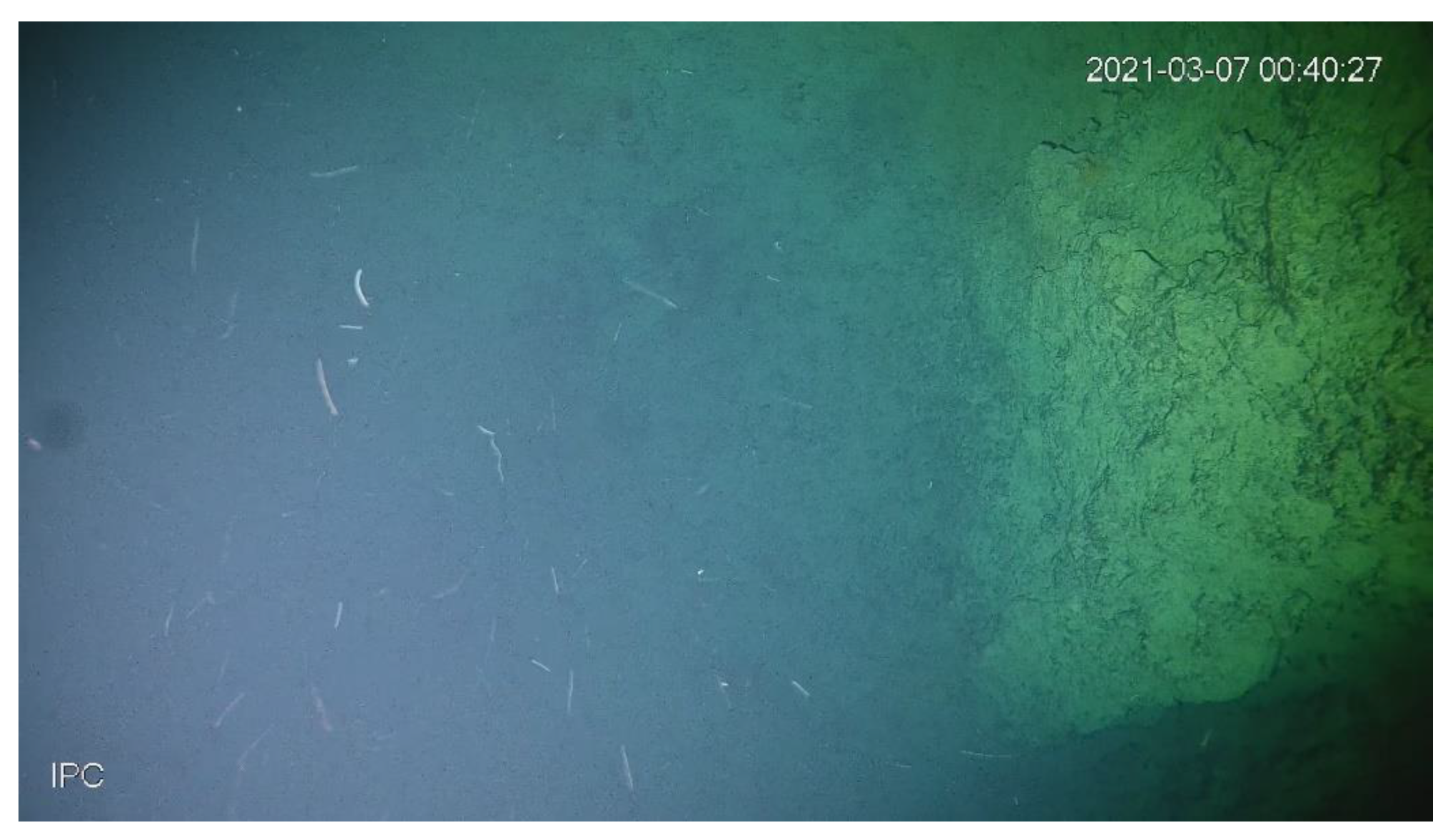
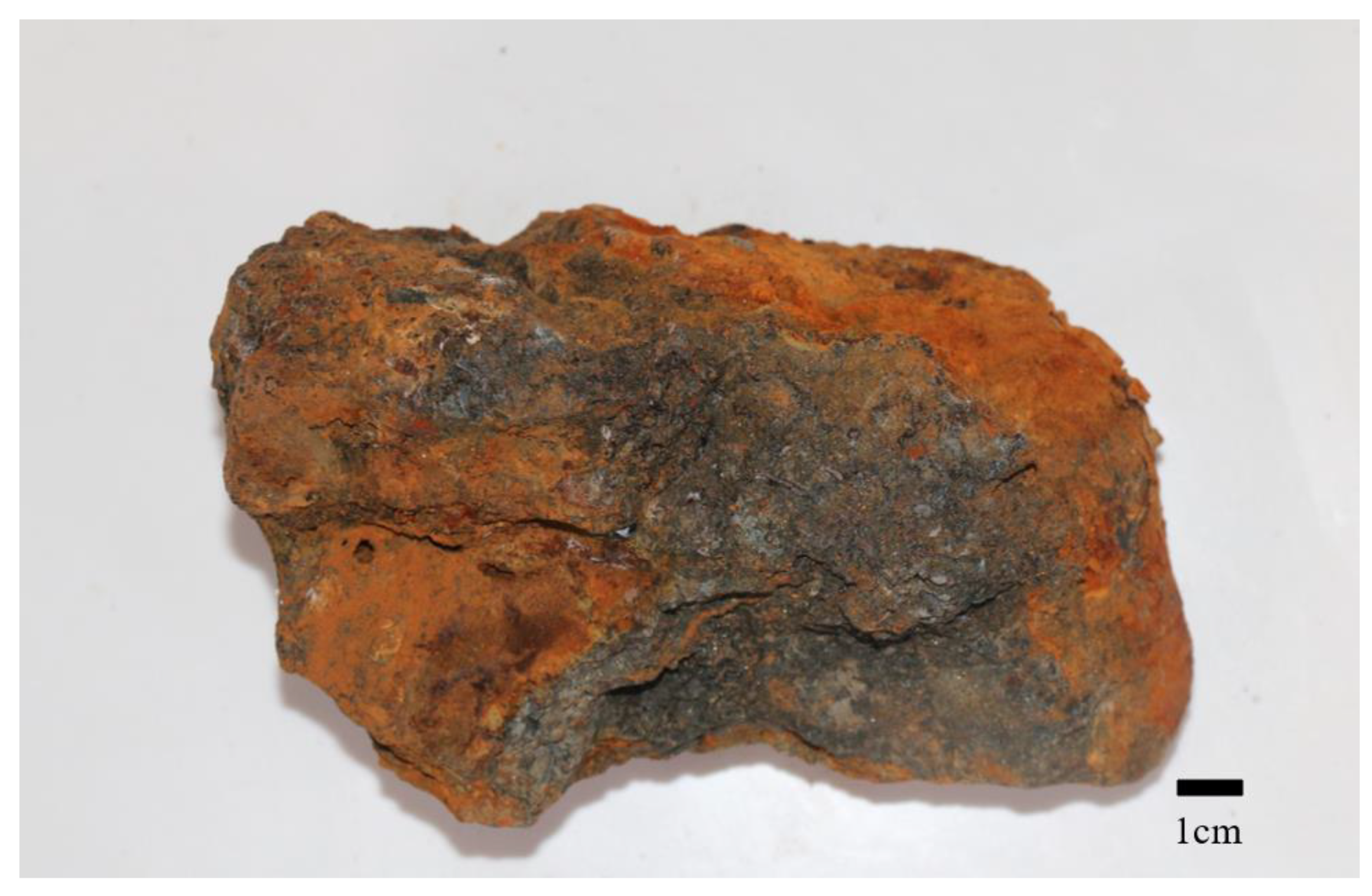
| Day | 10−5 M | 10−4 M | 10−3 M | 10−2 M | 10−1 M | Slope | R2 |
|---|---|---|---|---|---|---|---|
| 1 | 57.23 | 28.96 | −3.01 | −34.17 | −63.20 | −30.40 | >0.99 |
| 3 | 56.68 | 29.04 | −2.96 | −33.86 | −62.03 | −30.03 | >0.99 |
| 9 | 56.86 | 27.85 | −2.01 | −34.56 | −62.77 | −30.17 | >0.99 |
| 17 | 55.45 | 26.11 | −0.12 | −36.93 | −65.54 | −30.50 | >0.99 |
| 31 | 52.33 | 21.12 | −1.66 | −38.66 | −69.24 | −30.29 | >0.99 |
| 43 | 55.39 | 19.34 | 1.26 | −39.23 | −63.21 | −29.58 | >0.98 |
| 60 | 51.14 | 18.37 | 0.11 | −34.22 | −70.75 | −29.64 | >0.98 |
| Interfering Ions | Slope | R2 | logKi,j |
|---|---|---|---|
| SO42− | −30.62 | >0.99 | −3.16 |
| Cl− | −30.99 | >0.99 | −4.24 |
| Br− | −29.87 | >0.99 | −2.21 |
| NO2− | −31.22 | >0.98 | −3.36 |
| NO3− | −30.65 | >0.99 | −2.58 |
| CH3COO− | −31.87 | >0.98 | −1.96 |
| OH− | −29.94 | >0.99 | −3.44 |
Publisher’s Note: MDPI stays neutral with regard to jurisdictional claims in published maps and institutional affiliations. |
© 2021 by the authors. Licensee MDPI, Basel, Switzerland. This article is an open access article distributed under the terms and conditions of the Creative Commons Attribution (CC BY) license (https://creativecommons.org/licenses/by/4.0/).
Share and Cite
Zhang, C.; He, Y.; Wu, J.; Ai, M.; Cai, W.; Ye, Y.; Tao, C.; Zhang, P.; Jin, Q. Fabrication of an All-Solid-State Carbonate Ion-Selective Electrode with Carbon Film as Transducer and Its Preliminary Application in Deep-Sea Hydrothermal Field Exploration. Chemosensors 2021, 9, 236. https://doi.org/10.3390/chemosensors9080236
Zhang C, He Y, Wu J, Ai M, Cai W, Ye Y, Tao C, Zhang P, Jin Q. Fabrication of an All-Solid-State Carbonate Ion-Selective Electrode with Carbon Film as Transducer and Its Preliminary Application in Deep-Sea Hydrothermal Field Exploration. Chemosensors. 2021; 9(8):236. https://doi.org/10.3390/chemosensors9080236
Chicago/Turabian StyleZhang, Chuqing, Yang He, Jianbo Wu, Manqing Ai, Wei Cai, Ying Ye, Chunhui Tao, Pingping Zhang, and Quan Jin. 2021. "Fabrication of an All-Solid-State Carbonate Ion-Selective Electrode with Carbon Film as Transducer and Its Preliminary Application in Deep-Sea Hydrothermal Field Exploration" Chemosensors 9, no. 8: 236. https://doi.org/10.3390/chemosensors9080236
APA StyleZhang, C., He, Y., Wu, J., Ai, M., Cai, W., Ye, Y., Tao, C., Zhang, P., & Jin, Q. (2021). Fabrication of an All-Solid-State Carbonate Ion-Selective Electrode with Carbon Film as Transducer and Its Preliminary Application in Deep-Sea Hydrothermal Field Exploration. Chemosensors, 9(8), 236. https://doi.org/10.3390/chemosensors9080236







